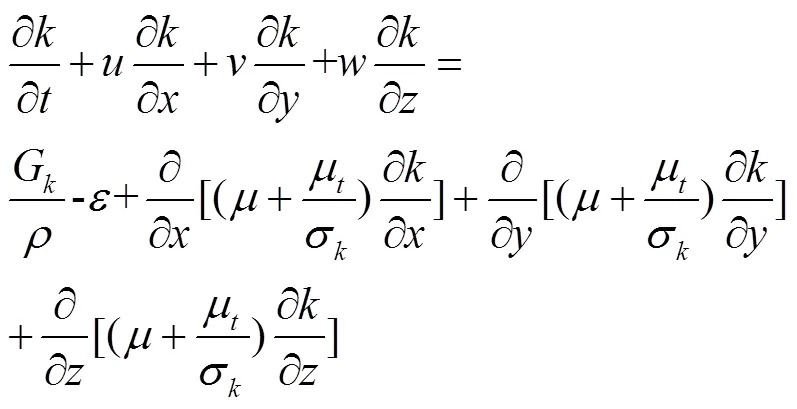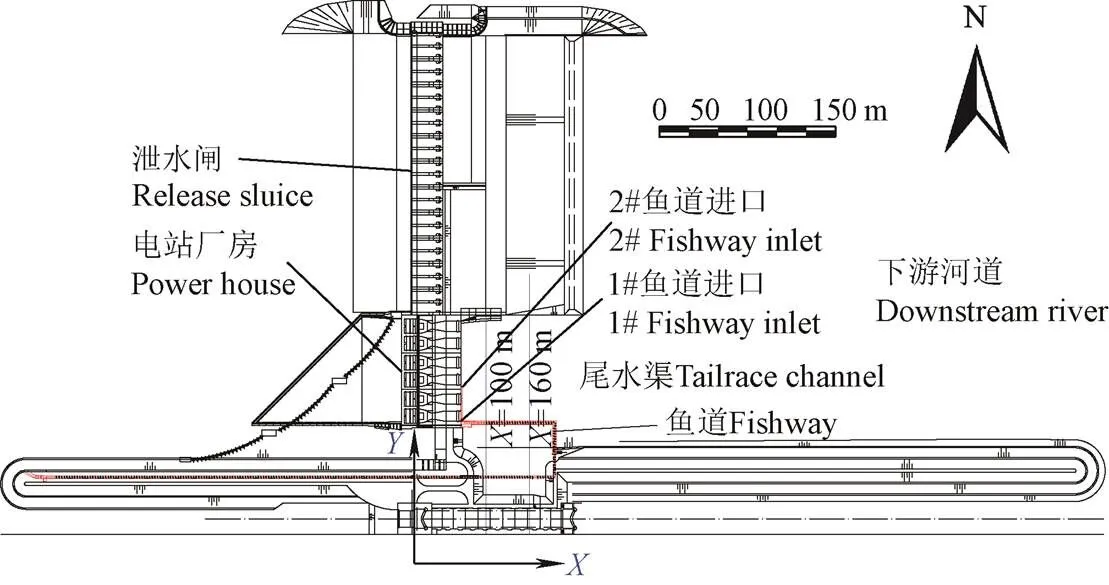电站尾水渠内鱼道进口位置布局
李广宁,孙双科,郄志红,郭子琪,,柳海涛,郑铁刚,孙娟娟
电站尾水渠内鱼道进口位置布局
李广宁1,孙双科1,郄志红2,郭子琪1,2,柳海涛1,郑铁刚1,孙娟娟3
(1. 中国水利水电科学研究院流域水循环模拟与调控国家重点实验室,北京 100038;2. 河北农业大学城乡建设学院,保定 071001;3. 湖北省水利水电规划勘测设计院,武汉 430064)
电站尾水渠是上溯鱼类较为理想的聚集场所,利用电站尾水渠合理布置鱼道进口,是目前大中型河流鱼道建设中的研究热点之一。该文通过数值模拟,结合鱼类游泳能力,对利用电站尾水诱鱼的鱼道进口布置进行研究。结果表明:机组运行方式、鱼道进口位置与出流方向均对鱼道进口诱鱼水流产生较大影响。机组运行方式决定了尾水渠内主流的位置,并在主流两侧形成多个回流区。回流区水流的旋转方向和位置对鱼道进口诱鱼水流的影响较大,鱼道进口的诱鱼水流动量较小,其出流方向应与回流区水流方向一致,并可根据电站运行方式,设置多个鱼道进口。主流与回流区之间的过渡区域是布置鱼道进口的重点区域。该研究结果可为优化改进大中型河流鱼道进口设计提供重要参考。
鱼道;流场;数值模拟;尾水渠;诱鱼水流;出流方向;机组运行方式
0 引 言
鱼道工程是洄游鱼类克服水头差,实现上溯的主要措施之一,在国内大中型水利工程中广泛应用。鱼道工程的设计主要包含2个方面的问题:一是鱼道内部布置体型对鱼类上溯行为的影响[1],二是鱼道进口布置对集鱼、诱鱼效果的影响[2]。在鱼道布置体型研究方面[3-6],国内外许多学者采用室内试验、数值模拟、原型观测等方法,结合鱼类洄游习性,提出了一系列适宜鱼类上溯的布置体型,及时满足了实际工程需要[7-9]。在鱼道进口诱鱼研究方面,目前国内外公认最经济有效的方法是在鱼道进口形成诱鱼水流[10],利用鱼类趋流性将其吸引至鱼道内[11]。因此,鱼道进口水流既是吸引鱼类的手段,又是鱼类进入鱼道所必须克服的障碍,其流速以大于目标鱼类的感应流速,又小于该鱼类的临界流速为宜[12,13]。
同时,诱鱼水流还应该与环境流场相互作用形成稳定、贯通的,并与目标鱼类的游泳能力相适应的上溯通道。由此可见,电站尾水渠内鱼道进口的布置方案与尾水渠内的流场均对鱼道进口的诱鱼效果产生较大的影响。
大中型河流中,鱼道进口的工程尺度通常相对较小[14],且设计流量普遍偏低,往往造成诱鱼水流动量不足、覆盖范围较小,诱鱼效果欠佳[15]。尽管如此,在实际工程中发现,电站尾水渠是鱼类较为理想的聚集场所,如湖北省兴隆枢纽工程和崔家营枢纽工程[16]、浙江省小溪滩电站[17]、楠溪江供水工程[18]等均有大量鱼类在尾水渠内聚集,在此布设鱼道进口具有较好的应用前景。然而,当鱼道进口设置在电站厂房尾水附近时,水轮机的下泄水流又容易使诱鱼水流变得模糊[19,20],从而降低鱼道进口诱鱼效率,如美国Pawtucket工程[21],尽管在尾水渠内布置有鱼道进口,由于位置欠佳,当电站运行时,流场条件恶化,使得鱼类无法找到鱼道进口继续上溯。因此,如何利用电站尾水渠合理布置鱼道进口,是目前大中型河流中鱼道建设所面临的关键问题之一。
现有的鱼道设计导则及相关研究中,对鱼道进口提出了一些基本的布置原则[22,23],但电站尾水渠内的流场结构复杂,鱼道进口诱鱼水流受到多种因素的影响,目前已有研究成果在指导鱼道进口在尾水渠内的具体布置尚缺乏针对性。本文以某大型电站尾水渠内鱼道进口布置方案为基础,使用软件Flow-3D进行数值模拟,对电站尾水诱鱼的鱼道进口布置进行研究,评价鱼道进口形成的过鱼通道与下游河道的联通效果,针对大中型河流尾水渠内鱼道进口提出布置建议。
1 数值模型及验证
1.1 基本方程及求解方法
数值模拟采用standard湍流模型[24],该模型基本方程包括水流连续方程、动量方程、紊动能及耗散率方程。
(1)连续方程

(2)动量方程



(3)紊动能方程

(4)紊动能耗散率方程

式(1)~(6)中,为时间,s;、、为时均速度在、、方向的分量,m/s;为密度,kg/m³;、μ分别为粘性系数和紊动粘性系数,m2/s;为时均压强,Pa;为紊动能,m2/s2;为紊动能耗散率,m2/s3;G为紊动能产生项,各项紊流常数取值为C=0.09,σ=1.3,σ=1.0,1ε=1.44,2ε=1.92。
液体自由表面采用VOF(volume of fluid)方法[25]进行处理,模型求解采用有限体积法,二阶迎风格式,压力-速度耦合采用压力校正法,离散方程的求解采用GMRES(generalized minimal residual)法,时间差分采用全隐格式。
1.2 研究区域及边界条件
研究区域包括某电站厂房尾水出口、尾水渠及下游部分河道,如图1所示。在电站1号机组尾水出口右侧,布置有1#鱼道进口;在2号与3号机组之间尾水出口隔墩上,布置2#鱼道进口;两个鱼道进口的出流速度均设定为1 m/s,出流方向均与坝轴线平行并指向左岸,两个鱼道进口的水深均大于1 m,以保证垂向水深满足过鱼要求。

图1 研究区域平面布置、鱼道进口布置及出流方向
利用数学模型研究各种运行条件下鱼道进口过鱼通道与诱鱼水流的变化规律。人工建筑物及河道天然地形采用嵌套加密的矩形网格,坐标与坝轴线平行,坐标与坝轴线垂直,坐标代表高程。鱼道出口附近网格尺寸为0.1 m,其余部位网格尺寸从0.3 m到1 m不等,网格总数约72万,研究区域三维数值模型如图2所示。

图2 研究区域三维数值模型
电站机组尾水出口为模型入流边界,依据计算工况不同,设定不同进流流量;自电站机组尾水出口向下游1.2 km处河道断面为模型出口,根据水位-流量关系及运行工况设定水位;周边固壁满足无滑移条件;液面为自由水面。
1.3 模型验证
在前期的研究中,针对某电站尾水渠(图3)流场进行了物理模型试验研究,几何比尺为1∶90,主要建筑物包括上游水库、泄水闸、消力池、防冲槽、下游河道、电站厂房等(图4)。其中电站采用河床式厂房,共6台机组,单机流量464 m3/s,机组尾水渠经反坡段与下游河道衔接。模型试验中采用电磁流量计控制流量;水位采用水位测针测量,测针最小刻度读数为0.1 mm;流速采用多普勒电磁流速仪(ADV)进行测量,试验中多次重复测量取平均值,测量精度为0.001 m/s。

注:X=100 m及X=160 m断面所在的坐标系原点位于坝轴线上。

图4 主要建筑物物理模型试验布置
运用本文数学模型,对电站3台机组同时运行的工况(1#+2#+3#)进行数值模拟。数学模型内尾水渠范围为=64~198 m,=68~213 m,针对尾水渠内=100 m和=160 m(图3)两个断面的表层(水面下1 m)流速与水面高程进行提取,并与试验结果[26]进行对比,如图5所示,计算值与试验值变化趋势一致。流速最大误差为0.03 m/s,水面线最大误差为5 mm。数学模型计算精度满足本文针对鱼道进口局部诱鱼流场开展细化研究的要求[27,28]。

图5 尾水渠典型断面实测与计算值比较
2 研究方案及判别条件
2.1 过鱼对象
过鱼对象主要为分布在长江流域的四大家鱼(青鱼、草鱼、鲢鱼、鳙鱼),河湖洄游鱼类[29],性成熟个体于4—7月进行生殖洄游[30]。四大家鱼在水体中的分布因习性而异[31],青鱼多于中层与底层水域活动,草鱼多于中层水域活动,鲢鱼多于表层水域活动,鳙鱼多于表层与中层水域活动。
2.2 过鱼通道及诱鱼水流优劣判断方法
过鱼通道内流速应大于目标鱼类的感应流速且小于鱼类临界流速[12,13]。本文中过鱼对象体长约200~500 mm,适宜过鱼对象洄游上溯的流速区间主要集中于0.4~1.2 m/s[32,33]。本研究中将下游河道内流速分为4个流速带,分别为0~0.4、0.4~0.8、0.8~1.2及>1.2 m/s。其中,0~0.4 m/s的流速分布区域,鱼类不易定位主流,为方向感较弱区,不宜作为过鱼通道;0.4~0.8 m/s 的流速分布区域,为鱼类喜好流速区域,可以较为轻松的上溯,为最优过鱼通道区域;0.8~1.2 m/s流速分布区,虽同样在过鱼对象喜好流速范围内,但鱼类上溯时需要耗费较多的能量,为辅助过鱼通道;大于1.2 m/s流速区,流速大于过鱼对象的临界流速,该区域不可作为过鱼通道,为流速屏障区[34]。
本文鱼道进口诱鱼水流的优劣按以下标准判断:1)诱鱼水流覆盖范围较大;2)诱鱼流速满足鱼类上溯要求;3)诱鱼水流与河流中的鱼类上溯通道相互连通;4)鱼道进口具有足够的水深。
3 计算结果及分析
3.1 尾水渠与河流之间的过鱼通道
电站机组运行时鱼类进入电站尾水渠的现象已被多个实践工程所证实,但关于洄游鱼类如何进入尾水渠尚缺定论。本文通过分析表1所示工况下尾水渠与下游河道间的过鱼通道,对该问题进行说明。

表1 不同运行工况下的流量与尾水渠水位
单台机组运行时,尾水出流占据尾水渠的部分面积,主流流速较高(>1.2 m/s),形成流速屏障;两侧流速适中(0.4~1.2 m/s),可形成过鱼通道,并自尾水渠一直连通至下游河道。河道中的鱼类往往被发电尾水吸引向尾水渠方向聚集,并可沿主流两侧的过鱼通道上溯至尾水渠内,直到机组尾水出口附近。如,1#机组运行时,主流靠近尾水渠右岸,左侧过鱼通道自尾水渠一直连通至下游河道(图6a、6b),6#机组运行时,在主流右侧形成过鱼通道(图6c、6d)。河流内的洄游鱼类沿尾水主流某一侧的过鱼通道上溯至尾水出口附近的概率较大。
多台机组运行时,虽然尾水出流占据了尾水渠内较大面积,但是在主流的两侧仍然可以形成过鱼通道,并与下游河道相连。如,1#+2#+3#机组运行时,主流靠近尾水渠右半部分,主流流速较高(>1.2 m/s),主流左侧形成过鱼通道(图6e、6f)。4#+5#+6#机组运行时,在主流右侧形成过鱼通道(图6g、6h)。由此可知,当过鱼通道贯穿整个尾水渠并与下游河道相连通时,洄游鱼类可沿过鱼通道上溯至机组尾水出口附近。
由以上分析可见,当尾水渠与河流之间存在适宜于鱼类洄游的过鱼通道时,鱼类能顺利上溯至机组尾水出口附近;当不存在过鱼通道时(图6i、6j),鱼类仍可上溯至闸坝下游消力池,伺机进入尾水渠。

注:图中坐标原点位于坝轴线上尾水渠右侧64m处,X坐标轴指向下游为正向,Y坐标轴指向左岸为正向。绿色区域为最优过鱼通道,黄色区域为辅助过鱼通道,红色区域为流速屏障。下同。
3.2 尾水渠内流场及过鱼通道
单台机组运行时,机组出流对诱鱼水流形成两种典型的影响方式。一种是,尾水出流导致鱼道出口附近形成回流区,诱鱼水流与回流区的水流方向相同,两股水流汇合,诱鱼水流覆盖范围加大,过鱼通道沿水流方向延长。如2#和3#机组分别单独运行时的1#鱼道进口处的过鱼通道。另一种是,尾水出口位于鱼道进口的外部,诱鱼水流难以穿透尾水出流,从而改变方向并与主流融合,过鱼通道沿主流边缘延伸至下游。如1#机组单独运行时的1#鱼道进口;3#机组单独运行时的2#鱼道进口处的过鱼通道,如图7所示。
多台机组运行时,尾水渠内形成具有多个回流区的复杂流场结构,其影响诱鱼水流的方式与单台机组类似,如图8所示。如,工况2#+4#机组、2#+5#机组、3#+4#机组运行时,1#鱼道进口的诱鱼水流与回流方向相同,两股水流汇合,覆盖范围得到加强;又如,3#+5#机组、3#+6#机组运行时,机组尾水出口正好位于2#鱼道进口的外部,诱鱼水流与主流合并。特别的,当诱鱼水流出流方向与旋转水流方向相反时,诱鱼水流往往被抑制,覆盖范围减小。如,工况2#+4#机组运行、2#+5#机组运行时,2#鱼道进口的诱鱼水流与回流方向相反,诱鱼水流被部分抵消,过鱼通道变短。
3.3 鱼道进口影响因素分析及布置建议
鱼道进口的出流方向、出流位置以及机组运行方式均对鱼道进口诱鱼水流产生较大影响(表2)。机组运行方式不仅决定了尾水渠内主流的位置,同时还形成了多个回流区,其旋转方向和位置对诱鱼水流的影响较大。当鱼道进口的诱鱼水流与回流区的旋转水流方向相一致时,诱鱼水流往往被加强,从而增加其覆盖范围。当鱼道进口的诱鱼水流与回流的旋转水流方向相矛盾时,往往被迫改变水流方向,其影响范围大大减小。即使鱼道进口的诱鱼水流的流速相对较高,但是由于诱鱼水流的动量较小,依然难以穿透回流区。

图7 单机运行典型过鱼通道

图8 两台机组运行典型过鱼通道
通过分析尾水渠内流场结构,认为尾水渠内鱼道进口布置方式可主要分为以下三类:
1)靠近边墙的一台机组单独运行时,可将主流与回流区之间的过渡区域作为布置鱼道进口的重点区域。此种流场结构中,主流居于尾水渠内正对机组出口的一侧,另一侧较为宽阔,未形成明显旋流,诱鱼水流难以穿透尾水出流,诱鱼水流适宜布置在主流边缘的位置,从而与主流汇合,形成沿主流边缘的过鱼通道,如图9a所示。
2)运行机组的出流位置距离边墙有一定距离时,鱼道诱鱼水流出流方向应与旋转水流方向保持一致。在此种流场结构中,主流与边墙间容易形成强烈的小型回流区,如图9b所示,若机组出流位置与边墙距离进一步加大,则该回流区的直径也增大,但是强度有一定程度减弱,即旋转水流的流速一定程度减小,如图9c所示,当水流沿坝轴线方向出流时,往往会获得较长的有效诱鱼范围。
3)机组间隔运行,即两台运行机组之间存在不运行的机组时,两个主流间形成两个逆向的回流区,两个回流区水流方向相反,如图9d所示。在此种流场结构中,布置原则与第二类水流结构类似,建议布置鱼道进口时保证鱼道诱鱼水流出流方向与旋转水流方向一致。

表2 不同机组运行方式对诱鱼水流的影响

4 结 论
本文采用三维数值模拟,通过分析电站尾水诱鱼的鱼道进口布置、电站机组运行方式对尾水渠内鱼道进口诱鱼水流的影响,对利用电站尾水诱鱼的鱼道进口布置进行了研究,得出以下结论:
1)电站机组运行时产生的水流具有较大动量,使尾水渠与河流之间产生适宜于鱼类洄游的过鱼通道,鱼类可以沿此通道上溯。
2)机组运行方式对鱼道进口位置的选择影响较大。不同的运行方式下过鱼通道位置有较大差异,且伴随不同尺度、位置的回流区,进口布置时应考虑其布置位置,尽可能在较多工况下使诱鱼水流与过鱼通道连接。
3)鱼道进口诱鱼水流动量较小,难以穿透尾水渠内的回流区。当诱鱼水流与回流区旋转水流方向一致时,水流得到增强,诱鱼范围增大;当诱鱼水流与回流区方向相反时,水流受到抑制,诱鱼范围减小。诱鱼水流方向应与回流的方向保持一致,主流与回流区之间的过渡区域是布置鱼道进口的重点区域。
[1]Rajaratnam N, Vinne G V D, Katopodis C. Hydraulics of vertical slot fishways[J]. Journal of Hydraulic Engineering, 1986, 112(10): 909-927.
[2]Li Guangning, Sun Shuangke, Liu Haitao, et al. Optimizing the entrance location for a fish pass facility with limited attraction flow in a large river: A case study of the Jinsha River, China[J]. Canadian Journal of Civil Engineering, 2019. Doi: 10. 1139/cjce-2018-0523.
[3]Liu M, Rajaratnam N, Zhu D Z. Mean flow and turbulence structure in vertical slot fishways[J]. Journal of Hydraulic Engineering, 2006, 132(8), 765-777.
[4]Kim S, Yu K, Yoon B, et al. A numerical study on hydraulic characteristics in the ice harbor-type fishway[J]. KSCE J Civil Eng, 2012, 16(2): 265-272.
[5]Marriner B A, Baki A B M, Zhu D Z, et al. Field and numerical assessment of turning pool hydraulics in a vertical slot fishway[J]. Ecological Engineering, 2014, 63: 88-101.
[6]李广宁,孙双科,郭子琪,等. 仿自然鱼道水力及过鱼性能物理模型试验[J]. 农业工程学报,2019,35(9):147-154. Li Guangning, Sun Shuangke, Guo Ziqi, et al. Physical model test on hydraulic characteristics and fish passing performance of nature-like fishway[J]. Transactions of the Chinese Society of Agricultural Engineering (Transactions of the CSAE), 2019, 35(9): 147-154. (in Chinese with English abstract)
[7]Marriner B A, Baki A B M, Zhu D Z, et al. The hydraulics of a vertical slot fishway: A case study on the multi-species Vianney-Legendre fishway in Quebec, Canada[J]. Ecological Engineering, 2016, 90, 190-202.
[8]徐体兵,孙双科. 竖缝式鱼道水流结构的数值模拟[J]. 水利学报,2009,40(11):1386-1391. Xu Tibing, Sun Shuangke. Numerical simulation of the flow structure in vertical slot fishway[J]. Journal of Hydraulic Engineering, 2009, 40(11): 1386-1391. (in Chinese with English abstract)
[9]边永欢,孙双科,竖缝式鱼道的水力特性研究[J]. 水利学报,2013,44(12):1462-1467. Bian Yonghuan, Sun Shuangke. Study on hydraulic characteristic of flow in the vertical slot fishway[J]. Journal of Hydraulic Engineering, 2013, 44(12): 1462-1467. (in Chinese with English abstract)
[10]Williams J G, Armstrong G, Katopodis C, et al. Thinking like a fish: A key ingredient for development of effective fish passage facilities at river obstructions[J]. River Res Appl, 2012, 28, 407-417.
[11]Cheong T S, Kavvas M L, Anderson E K. Evaluation of adult white sturgeon swimming capabilities and applications to fishway design[J]. Environmental Biology of Fishes, 2006, 77(2): 197-208.
[12]赵希坤,韩桢锷. 鱼类克服流速能力的试验[J]. 水产学报,1980,4(1):31-37. Zhao Xikun, Han Zhene. Experiments on the current overcoming ability of some freshwater fishes[J]. Journal of Fisheries of China, 1980, 4(1): 31-35. (in Chinese with English abstract)
[13]Rodríguez T T, Agudo J P, Mosquera L P, et al. Evaluating vertical-slot fishway designs in terms of fish swimming capabilities[J]. Ecological Engineering, 2006, 27(1): 37-48.
[14]FAO/DVWK. Fish Passes-Design, Dimensions and Monitoring[M]. Rome: FAO, 2002.
[15]Katopodis C, Williams J G. The development of fish passage research in a historical context[J]. Ecological Engineering, 2011, 48(7), 8-18.
[16]王珂,刘绍平,段辛斌,等. 崔家营航电枢纽工程鱼道过鱼效果[J]. 农业工程学报,2013,29(3):184-189. Wang Ke, Liu Shaoping, Duan Xinbin, et al. Fishway effect of Cuijiaying navigation-power junction project[J]. Transactions of the Chinese Society of Agricultural Engineering (Transactions of the CSAE), 2013, 29(3): 184-189. (in Chinese with English abstract)
[17]王桂华,夏自强,吴瑶,等. 鱼道规划设计与建设的生态学方法研究[J]. 水利与建筑工程学报,2007,5(12):7-12. Wang Guihua, Xia Ziqiang, Wu Yao, et al. Study on designing and building of fishway by using ecological way[J]. Journal of Water Resources and Architectural Engineering, 2007, 5(12), 7-12. (in Chinese with English abstract)
[18]史斌,王斌,徐岗,等. 浙江楠溪江拦河闸鱼道进口布置优化研究[J]. 人民长江,2011,42(1):69-71. Shi Bin, Wang Bin, Xu Gang, et al. Research on optimization of fishway entrance of sluice on Nanxi Riverin Zhejiang Proxince[J]. Yangtze River, 2011, 42(1): 69-71. (in Chinese with English abstract)
[19]Barry T, Kynard B. Attraction of adult American shad to fish lifts at Holyoke Dam, Connecticut River[J]. North American Journal of Fisheries Management, 1986, 6(2): 233-241.
[20]Larinier M, Chanseay M, Bau F, et al. The use of radio telemetry for optimizing fish pass design[C]//Aquatic Telemetry Advances and Applications: Proceedings of The Fifth Conference on Fish Telemetry Ustica. Rome, FAO, 2003.
[21]Sprankle K. Interdam movements and passage attraction of American shad in the lower Merrimack River mainstem[J]. North American Journal of Fisheries Management, 2005, 25(4): 1456-1466.
[22]国家能源局. NB/T35054—2015 水电工程过鱼设施设计规范[S]. 北京:中国电力出版社,2015.
[23]汪亚超,陈小虎,张婷,等. 鱼道进口布置方案研究[J]. 水生态学杂志,2013,34(4):30-34. Wang Yachao, Chen Xiaohu, Zhang Ting, et al. Study on layout scheme of fishway entrance[J]. Journal of Hydroecology, 2013, 34(4): 30-34. (in Chinese with English abstract)
[24]李广宁,孙双科,柳海涛,等. 仿自然鱼道中卵石墙对池室水力特性改善效果[J]. 农业工程学报,2017,33(15):184-189. Li Guangning, Sun Shuangke, Liu Haitao, et al. Improving effect of hydraulic characteristics of nature-like fishway with pools and cobblestone weirs[J]. Transactions of the Chinese Society of Agricultural Engineering (Transactions of the CSAE), 2017, 33(15): 184-189. (in Chinese with English abstract).
[25]Hirt C W, Nichols B D. Volume of Fluid (VOF) method for the dynamics of free boundaries[J]. Journal of Computational Physics, 1981, 39, 201-225.
[26]李瑞清,李文峰,姚晓敏,等. 湖北碾盘山水利水电枢纽工程整体水工模型试验研究报告[R]. 武汉:湖北省水利水电勘测设计院,2017.
[27]孙双科,李广宁,柳海涛,等. 金沙江上游苏洼龙水电站过鱼设施模型试验研究报告[R]. 北京:中国水利水电科学研究院,2017.
[28]Moriasi D N, Arnold J G, Liew MWV, et al. Model evaluation guidelines for systematic quantification of accuracy in watershed simulations[J]. Transactions of the American Society of Agricultural and Biological Engineers, 2007, 50(3): 885-900.
[29]李建,夏自强,戴会超,等.三峡初期蓄水对典型鱼类栖息地适宜性的影响[J]. 水利学报,2013,44(8):892-900. Li Jian, Xia Ziqiang, Dai Huichao, et al. Effect of the Three Gorges Reservoir initial filling on downstream habitat suitability of the typical fishes[J]. Journal of Hydraulic Engineering, 2013, 44(8): 892-900. (in Chinese with English abstract)
[30]王尚玉,廖文根,陈大庆,等. 长江中游四大家鱼产卵场的生态水文特性分析[J]. 长江流域资源与环境,2008(6):892-897. Wang Shangyu, Liao Wengen, Chen Daqing, et al. Analysis of eco-hydrological characteristics of the four Chinese farmed carps' spawning grounds in the middle reach of the Yangtze river[J]. Resources and Environment in the Yangtze Basin, 2008(6): 892-897. (in Chinese with English abstract)
[31]许承双,艾志强,肖鸣. 影响长江四大家鱼自然繁殖的因素研究现状[J]. 三峡大学学报:自然科学版,2017,39(4):27-30, 59. Xu Chengshaung, Ai Zhiqiang, Xiao Ming. A review of influencing factors on natural reproduction of four major Chinese carps in Yangtze River[J]. Journal of China Three Gorges University(Natural Sciences), 2017, 39(4): 27-30, 59. (in Chinese with English abstract)
[32]熊锋,增强船闸过鱼能力的水流诱鱼试验研究及数值模拟[D]. 宜昌:三峡大学,2015. Xiong Feng. Experiment Study about Attractive Effects for Fish in Different Flow Velocity at Ship Lock Model[D]. Yichang: China Three Gorges University, 2015. (in Chinese with English abstract)
[33]熊锋,王从锋,刘德富,等. 松花江流域青鱼、草鱼、鲢及鳙突进游速比较研究[J]. 生态科学,2014,33(2):339-343. Xiong Feng, Wang Congfeng, Liu Defu, et al. Comparative study of burst swimming speed of black carp, grass carp, silver carp and bighead carp from Songhua River[J]. Ecological Science, 2014, 33(2): 339-343. (in Chinese with English abstract)
[34]郑铁刚,孙双科,柳海涛,等. 基于鱼类行为学与水力学的水电站鱼道进口位置选择[J]. 农业工程学报,2016,32(24):164-170. Zheng Tiegang, Sun Shuangke, Liu Haitao, et al. Location choice of fishway entrance in hydropower project based on fish behavioristics and hydraulics[J]. Transactions of the Chinese Society of Agricultural Engineering (Transactions of the CSAE), 2016, 32(24): 164-170. (in Chinese with English abstract)
Arrangement of fishway entrance in power station tailrace channel
Li Guangning1, Sun Shuangke1, Qie Zhihong2, Guo Ziqi1,2, Liu Haitao1, Zheng Tiegang1, Sun Juanjuan3
(1.,,100038,; 2.,,071001,; 3.,430064,)
In large and middle rivers, the scale of the fish way entrance is relatively small, and the design discharge is really low, which often leads to insufficient momentum of the attraction flow, and induce poor attraction effect. In practice, tailrace channel of power station is an ideal gathering place for the migration fish. Therefore, how to reasonable arrange the fishway entrance in tailrace channel is one of the key problems in fishway construction in nowadays. Although, there are some basic principles for the fishway entrance layout, but they are not enough to apply because of the complexity of flow field structure in the tailrace channel. The present research results are still not effectively to guide the specific layout of the fishway entrance in the tailrace channel. In this paper, numerical simulations are used to study the flow field for the arrangement of fishway entrance in the tailrace channel, and to evaluate the connectivity of the migration corridor to downstream river. First of all, a physical model experiment is carried out to verify the numerical model, the maximum error of the flow velocity is 0.03 m/s and the maximum error of the water surface line is less than 5 mm. Then, the numerical simulation is used to analyze the fishway entrance arrangement in the tailrace of a power station, based on the typical three-dimensional flow structure and the swimming ability of the fish. The results showed that the water flow produced by the power station unit has great momentum, and a passage which is suitable for fish migration is formed between the tail water channel and the river. The inducing fish flow is greatly influenced by the operation mode of the unit, the location of the fish inlet and the outlet direction. The operation mode of the power station not only determines the location of the main stream in the tailrace, but also forms several recirculation zones on both sides of the main stream. The flow rotation direction and position in recirculation zones have great influence on the inducing fish flow. The transition region between the mainstream and the recirculation zones is the key area for the layout of the fishway entrance. The selection of the specific location should consider the swimming ability of fish, and the connectivity with the migratory passage downstream. Because the momentum of attraction flow is less than flow of the recirculation zones, the former is enhanced and the coverage range is increased when the attraction flow has the same flow direction with the recirculation zones. When the attraction flow is opposite to the flow direction of the recirculation zones, it is restrained and the cover range will be reduced. The layout design of fish entrance should be designed through the operation mode of the power unit reasonable position and outflow direction. In practice the momentum of attraction flow is usually relatively small, the direction of the attraction flow should be in accordance with the direction of the flow in recirculation zones, and the fish entrances can be arranged in multiple locations according to the operation mode of the unit. The research results will provide important reference for the layout optimization of the fishway entrance design in the large and medium-sized river.
fishways; flow field; numerical simulation; tailrace channel; attraction flow; outflow direction; operation mode of unit
李广宁,孙双科,郄志红,郭子琪,柳海涛,郑铁刚,孙娟娟. 电站尾水渠内鱼道进口位置布局[J]. 农业工程学报,2019,35(24):81-89.doi:10.11975/j.issn.1002-6819.2019.24.010 http://www.tcsae.org
Li Guangning, Sun Shuangke, Qie Zhihong, Guo Ziqi, Liu Haitao, Zheng Tiegang, Sun Juanjuan. Arrangement of fishway entrance in power station tailrace channel[J]. Transactions of the Chinese Society of Agricultural Engineering (Transactions of the CSAE), 2019, 35(24): 81-89. (in Chinese with English abstract) doi:10.11975/j.issn.1002-6819.2019.24.010 http://www.tcsae.org
2019-07-30
2019-12-06
国家自然科学基金(51709278,51679261);国家重点实验室团队重点项目(SKL2018ZY08);中国水科院青年研究专项(HY0145B162019,HY0145B152018)
李广宁,高级工程师,博士,主要从事水力学研究工作。Email:lgnchina@163.com
10.11975/j.issn.1002-6819.2019.24.010
S956
A
1002-6819(2019)-24-0081-09

